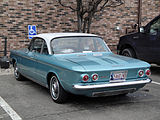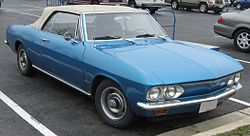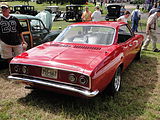Chevrolet Corvair
| Chevrolet Corvair | |
|---|---|
| Production period: | 1959-1969 |
| Class : | Middle class |
| Body versions : | Sedan , station wagon , coupé , convertible |
The Chevrolet Corvair is an American rear-wheel drive car produced by the General Motors subsidiary Chevrolet . The car with an air-cooled six - cylinder boxer engine in the rear was built from 1959 to 1969.
Model year 1959–1964
| Corvair 500 series (1960–1964) Corvair Monza Spyder 600 series (1964) Corvair Deluxe 700 series (1960–1964) Corvair Monza 900 series (1960–1964) |
|
|---|---|
|
Chevrolet Corvair (1960–1964) |
|
| Production period: | 1959-1964 |
| Body versions : | Sedan , station wagon , coupé , convertible |
| Engines: |
Gasoline engines : 2.3–2.7 liters (48–110 kW) |
| Length: | 4572 mm |
| Width: | 1699 mm |
| Height: | 1341 mm |
| Wheelbase : | 2743 mm |
| Empty weight : | 1125-1200 kg |
The Corvair was intended to expand General Motors' program downwards and, like the competing models Ford Falcon and Plymouth Valiant, which appeared at the same time , offer an alternative to the increasingly successful import cars at the end of the 1950s, primarily the VW Beetle .
The technical solution offered with a rear engine made the Corvair unique. While for decades all American passenger cars followed the standard design (water-cooled, longitudinally installed front engine , rear-wheel drive ), GM based the Corvair - as the only American series car - on the VW Beetle. Like this one, he got an air-cooled boxer engine built into the rear. As a concession to US customers, the six-cylinder engine with a displacement of over 2 liters was, however, significantly more powerful than that of the VW Beetle.
In addition to the four-door sedan, there was also a five-door station wagon called Lakewood , a two-door coupé and a two-door convertible. A minibus (similar to the VW bus) was available under the name Chevrolet Greenbrier Sportswagon . The body shape of the first series (1960 to 1964) with the belt line emphasized by a circumferential bead was the model for the NSU Prinz 4 , Fiat 1300 and the ZAZ 968 .
In October 1959, the Corvair was launched on the market as a two-door coupé and four-door sedan, equipped as a 500 Standard or 700 Deluxe , powered by a six-cylinder boxer engine with almost 2.3 liters of displacement and one carburetor per cylinder bank , the 80 SAE-PS gross (65 PS net / DIN, 48 kW) or with another camshaft 95 SAE-PS gross. The transmission was an automatic with two gears or a manual transmission with three or four gears.
For the 1961 model year, the range was expanded to include the 900 Monza , a five-door station wagon named Lakewood , a minibus named Greenbrier , a panel van named Corvan , and the Corvair 95 pick-up. At the same time, the factory increased the displacement to 2.4 liters, with the nominal output remaining unchanged.
From 1962 the basic model was only available as a coupé and an additional convertible. These two two-door models were also available as Monza Spyder with a turbocharger and 150 hp / 152 hp. From autumn 1963, the engines were enlarged to 2.7 liters and the naturally aspirated version produced 95 hp / 96 hp, with the Monza Spyder turbo still 152 hp. The turbo version has been upgraded again and recently also offered with a 2.9 liter engine and 180 hp. There was also a four-door sedan with a 2.7 liter engine and 112 hp (700 series, body type 1959–1964) manufactured in the GM assembly plant in Biel / Bienne , Switzerland, for the year of construction 1964
| Model year | Quantities |
|---|---|
| 1960 | 250.007 |
| 1961 | 297,881 |
| 1962 | 306.023 |
| 1963 | 254,571 |
| 1964 | 199,387 |
Model year 1965–1969
| Corvair 500 Series 101 (1965–1969) Corvair Monza Series 105 (1965–1969) Corvair Corsa Series 107 (1965–1966) |
|
|---|---|
|
Chevrolet Corvair Cabriolet (1965-1969) |
|
| Production period: | 1965-1969 |
| Body versions : | Sedan , coupe , convertible |
| Engines: |
Petrol engines : 2.7 liters (70-103 kW) |
| Length: | 4655 mm |
| Width: | 1780 mm |
| Height: | 1300 mm |
| Wheelbase : | 2743 mm |
| Empty weight : | 1080-1255 kg |
In September 1964, Chevrolet presented the second generation Corvair with an unchanged wheelbase of 2743 mm with a slightly larger body. Initially, the base model Corvair 500 was delivered as a hardtop coupé and limousine, the better equipped Corvair Monza as a coupé, limousine and convertible, and as the new sporty top model of the Corvair Corsa only as a coupé and convertible. The Corsa was powered by a high-performance version of the 2.7-liter (140 hp / 142 PS) - the turbo version was throttled to 140 hp / 142 PS at an additional cost or still available as the top version with 180 hp / 183 PS - , the other models from the previous 95 hp / 96 hp version of this machine (there was also a variant with 110 hp / 112 hp for an extra charge). In 1967 the Corsa was discontinued and with it the 180 hp version of the turbo engine. The four-door sedan was withdrawn from the range for the 1968 model year; thus the basic model as a coupé and the Monza as a coupé and convertible remained on offer. It stayed that way until production ended on May 14, 1969.
| Model year | Quantities |
|---|---|
| 1965 | 235,500 |
| 1966 | 103,743 |
| 1967 | 27,253 |
| 1968 | 15,400 |
| 1969 | 6,000 |
Security problems and facelift
The rear suspension of the Corvair consisted of a pendulum axle until model year 1964 , i.e. the drive shafts guided by swing arms had joints on the inside of the differential and were rigidly connected to the wheel hubs on the outside. The driving behavior of the vehicles is typical for this construction: If you oversteer and drive in a sporty way up to the limit speed, the camber changes in a positive direction if the speed is too high (especially on bumps) (the wheel buckles inwards). The result is an abrupt increase in oversteer , i.e. the rear of the car breaking away. Some engineers at Chevrolet had concerns while testing the vehicle; the quite simple and inexpensive to manufacture chassis was only defused by specifying certain tire pressures - much higher at the rear than at the front. Unfortunately, this information in the operating instructions was often misinterpreted as a misprint and not followed.
After numerous accidents with a few fatalities, the rear axle was revised for model year 1964: an additional compensating spring was attached to reduce the rebound of the inner wheel on the bend. The harder suspension was no longer available; all vehicles now got a stronger stabilizer at the front. The drum brakes have also been revised.
For model year 1965, the rear swing axle was replaced by the rear independent wheel suspension with central link and two wishbones (the upper one was the drive shaft), which was taken over from the Chevrolet Corvette . This means that the Corvair's handling was still typical of a rear-engined car; the oversteer was now easier to control.
The campaign against the Corvair
In the first years of production, the Corvair was quite successful and reached production numbers of 200,000 to 300,000 units annually (for exact numbers see above). In 1965, the car hit the headlines, especially through the traffic safety campaign of consumer protection lawyer Ralph Nader , who accused the Corvair of "dangerous driving behavior" in his book "Unsafe at Any Speed (1965)".
The Corvair had a weight distribution of 60 to 63% on the rear axle and a tire pressure distribution that was outside the usual norm: 15/26 psi (1.0 / 1.8 bar ) front / rear. The heavy engine and the pendulum axle, in conjunction with weak shock absorbers and diagonal tires, led to "lack of straight-line stability, sensitivity to crosswinds and seamless oversteer ". Its driving characteristics corresponded in principle to the contemporary European rear-engined cars ( Volkswagen , Škoda , NSU , Renault , Simca , Porsche ), but these vehicles were significantly lighter and had less engines. While the usual American car was designed for understeer , the Corvair had to be steered differently when cornering than the American driver was used to.
As a result, the demand for the Corvair dropped suddenly from 1966. The reputation of the relatively small, well-motorized and therefore sporty vehicle was ruined exactly at the time when the improvements were introduced into series production. Due to the decline in sales, the Corvair was discontinued in 1969 without a successor.
Electric prototypes
With the Chevrolet Electrovair from 1964 and 1965, General Motors Advanced Engineering Group developed two test vehicles with electric drives . After the Corvette, the Corvair was chosen as the second lightest car from Chevrolet for the conversion, the rear engine was advantageous for this. Both were based on the four-door sedan. In the first, the rear doors were welded shut to give the vehicle more rigidity. The traction battery made of silver-zinc accumulators with a total voltage of 532 V increased the empty weight from 2500 lb (1134 kg) to about 3000 lb (1684 kg) and could be charged about 100 times before it had to be replaced. The range per charge was 40 to 80 miles (about 65–130 km). The batteries filled the trunk and engine compartment. This made it necessary that components had to be accommodated instead of the rear seat bench. A 115 kW electric motor from AC Delco was used . With a top of 80 mph (almost 130 km / h) and an acceleration of 16 seconds to 60 mph (96 km / h), the performance was comparable to the production car. The initial equipment cost US $ 160,000 many times that of a new car. Electrovair II is often referred to as the 1966 model. It is now part of the collection of the GM Heritage Center .
literature
- James M. Flammang, Ron Kowalke: Standard Catalog of American Cars, 1976-1999. 3rd edition. Krause Publications, Iola WI 1999, ISBN 0-87341-755-0 , pp. 216-225.
- Olaf von Fersen (ed.): A century of automobile technology. Passenger cars. VDI Verlag 1986, ISBN 3-18-400620-4 .
Web links
- Technical data for the Chevrolet Corvair at boxermotor.com
- Collection of links to the Corvair at oldie-ausfahrten.de
- German Corvair fan club
- Swiss Corvair fan club
- Contemporary advertising trailer for the Corvair (English)
- motortrend.com: GM electric Vehicles through the years (English)
- aolautos.com: Forgotten concept: 1966 Chevy Electrovair II (English)
- conceptcarz.com: Chevrolet Electrovair II Experimental (English)
- robson.m3rlin.org: Chevrolet Electrovair II Experimental 4dr Hardtop (English)
Individual evidence
- ↑ a b 1960 Chevrolet Corvair . General Motors, February 1960 ( PDF, 1.17 MB, GM Heritage Center ).
- ↑ Olaf von Fersen (ed.): A century of automobile technology. Passenger cars. VDI Verlag 1986, ISBN 3-18-400620-4 , p. 44.
- ↑ PMC 3020193 (free full text) Unsafe at Any Speed: The Designed-In Dangers of the American Automobile (accessed on July 9, 2016)
- ↑ caranddriver.com General Motors Celebrates a 100-Year History of Technological Breakthroughs (accessed July 9, 2016)
- ↑ Olaf von Fersen (ed.): A century of automobile technology. Passenger cars. VDI Verlag 1986, ISBN 3-18-400620-4 , p. 46.
- ↑ Inside the Amazing General Motors Heritage Center , Jan. 11, 2011
| Timeline of Chevrolet Car Models in the United States from 1950 to 1979 - next » | ||||||||||||||||||||||||||||||
|---|---|---|---|---|---|---|---|---|---|---|---|---|---|---|---|---|---|---|---|---|---|---|---|---|---|---|---|---|---|---|
| Type | 1950s | 1960s | 1970s | |||||||||||||||||||||||||||
| 0 | 1 | 2 | 3 | 4th | 5 | 6th | 7th | 8th | 9 | 0 | 1 | 2 | 3 | 4th | 5 | 6th | 7th | 8th | 9 | 0 | 1 | 2 | 3 | 4th | 5 | 6th | 7th | 8th | 9 | |
| Small car | Vega | |||||||||||||||||||||||||||||
| Monza | ||||||||||||||||||||||||||||||
| Chevette | ||||||||||||||||||||||||||||||
| Compact class | Corvair | Corvair | ||||||||||||||||||||||||||||
| Chevy II / Nova | nova | nova | nova | |||||||||||||||||||||||||||
| Middle class | Chevelle / Malibu | Chevelle / Malibu | Malibu | |||||||||||||||||||||||||||
| Monte Carlo | Monte Carlo | Monte Carlo | ||||||||||||||||||||||||||||
| Full-size cars | Special | Special 150 | One-fifty | Del Ray | ||||||||||||||||||||||||||
| Deluxe | Deluxe 210 | Two-ten | Biscayne / Brookwood | |||||||||||||||||||||||||||
| Bel Air | Bel Air | Bel Air | Bel Air | Bel Air | ||||||||||||||||||||||||||
| impala | impala | impala | impala | impala | ||||||||||||||||||||||||||
| Nomad | Nomad | Caprice | Caprice | Caprice | ||||||||||||||||||||||||||
| Sports car | Camaro | Camaro | ||||||||||||||||||||||||||||
| Corvette C1 | Corvette C2 | Corvette C3 | ||||||||||||||||||||||||||||








